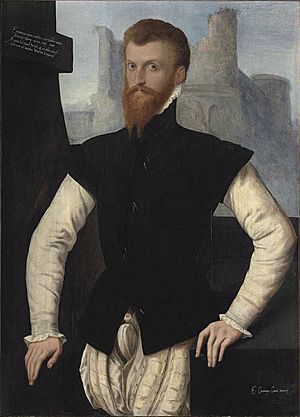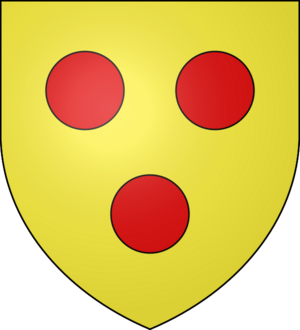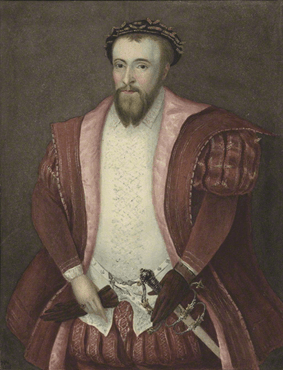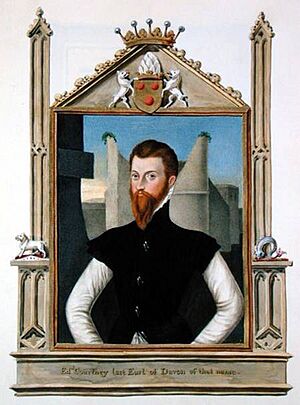Edward Courtenay, 1st Earl of Devon facts for kids
Quick facts for kids
Edward Courtenay
|
|
|---|---|

Edward Courtney, Earl of Devon, unknown artist, English School, c. 1555
|
|
| Born | 1526 |
| Died | 9 September 1556 (aged 29) |
| Title | Earl of Devon |
| Spouse(s) | Laurana de' Medici (Rumored) |
| Parent(s) | Henry Courtenay, 1st Marquess of Exeter Gertrude Blount |
Edward Courtenay, 1st Earl of Devon (born around 1527 – died 18 September 1556) was an English nobleman during the Tudor period. He came from a family with close ties to the royal family. At different times, people thought he might marry the two daughters of King Henry VIII. Both of these daughters later became queens of England. Edward was a second cousin to King Edward VI, Queen Mary I, and Queen Elizabeth I. This connection came through King Edward IV.
Contents
Early Life and Family Connections
Edward Courtenay was the only son of Henry Courtenay, 1st Marquess of Exeter (who lived from about 1498 to 1539). His mother was Gertrude Blount. Edward's grandmother was Princess Catherine of York. She was a daughter of King Edward IV. This made her a sister to King Edward V and an aunt to King Richard III. Catherine was also the sister of Elizabeth of York, who married King Henry VII. Elizabeth of York was the mother of King Henry VIII.
Because of these family links, Edward Courtenay was a cousin to King Henry VIII. He was also a second cousin to Queen Mary I, Queen Elizabeth I, and King Edward VI.
Life at Court
Edward's early years were mostly peaceful. He spent some time living with Mary Tudor, who was the Duchess of Suffolk. After she passed away in 1533, Edward went back to his own family. He received private lessons from a teacher named Robert Taylor.
Edward's father, the Marquess of Exeter, was a close friend of King Henry VIII in the 1520s. However, his father later faced suspicion. This was because Edward's mother supported Catherine of Aragon, King Henry VIII's first wife, after their marriage ended. There were also rumors that Edward's father planned for Edward to marry Princess Mary.
Years in Prison
In November 1538, Edward Courtenay and his parents were arrested. They were sent to the Tower of London. Edward's father was accused of planning a Catholic uprising. This was part of something called the Exeter conspiracy. His father was executed in January 1539. Both Edward and his mother lost their right to inherit his father's titles and lands.
Edward's mother was released from prison in 1540. She remained friends with Mary Tudor, King Henry VIII's oldest daughter. However, Edward was a great-grandson of King Edward IV. This made him a possible heir to the throne. The House of Tudor rulers saw him as a threat. So, Edward remained imprisoned.
In 1547, King Henry VIII died. His son, Edward VI, became king. The new king offered a general amnesty, which meant forgiveness for many prisoners. But Edward Courtenay was one of the few who was not released.
While still in prison, Edward translated a book called Benefizio di Cristo into English. He gave this book to Anne Stanhope. She was the wife of Edward Seymour, 1st Duke of Somerset, who was King Edward VI's uncle. A copy of this book, signed by King Edward VI himself, is in the Cambridge University Library. Edward Courtenay might have hoped this gift would help him get out of prison. But it did not lead to his release.
King Edward VI died on July 6, 1553. Lady Jane Grey was briefly named queen. But Mary Tudor, the king's older half-sister, was declared queen instead. Edward's mother, Gertrude Blount, was still a close friend of Mary. She helped secure Edward's release on August 3, 1553. He had been in the Tower of London for 15 years.
Life After Release
After his release, Edward quickly became a favorite of his cousin, Queen Mary. She helped him greatly. Mary made him Earl of Devon on September 3, 1553. He also became a Knight of the Bath later that month. On October 1, 1553, Mary was crowned queen. The new Earl of Devon carried the Sword of State during the ceremony. On October 10, 1553, Edward was given back his father's lands and titles. However, he was not allowed to become Marquess of Exeter.
Queen Mary showed Edward much kindness. Edward thought he might become the Queen's husband. Some people, including Bishop Stephen Gardiner, encouraged this idea. Spanish ambassadors reported that many people believed he would marry the Queen. This was because he was related to the royal family. But Mary chose to marry King Philip II of Spain instead.
Edward still hoped to have a role in the royal family. He then turned his attention to Mary's younger half-sister, Elizabeth. Since Mary had no children, Elizabeth was next in line to the throne. Mary and Philip's marriage was very unpopular in England. Some important people suggested that Elizabeth and Edward Courtenay should replace them on the throne.
Then, in January 1554, Wyatt's rebellion happened. Thomas Wyatt the Younger was a Protestant who feared Catholic persecution under Mary and Philip. He led a rebellion to stop the marriage. He also wanted to take control of Mary. The rebellion was quickly put down. There were rumors that Edward Courtenay had talked with Wyatt. People also said he was planning similar revolts in other parts of England.
Edward Courtenay and Elizabeth were thought to be involved in the rebellion. Both were sent to the Tower of London to await trial. Edward was later moved to Fotheringhay Castle. There was much talk linking Edward and Elizabeth to the rebellion. But there was no strong proof that they helped organize it. Neither of them marched with the rebels. They were not involved in the fighting. Mary and Philip were married on July 25, 1554.
No one could prove that Edward or Elizabeth were guilty. Elizabeth was first placed under house arrest. She was later released and allowed to return to court. In 1555, Edward was also released. He was sent away to Continental Europe. In November 1555, he wrote a letter from Brussels. He asked to return to England to see Queen Mary and his mother. His mother and Mary were still close friends. But Edward had lost Mary's trust. His request was denied.
He was still the Earl of Devon and kept his property. But he was not allowed to return to England. Both Mary and Elizabeth refused to have anything more to do with him. Elizabeth felt he was partly to blame for her imprisonment. She reportedly disliked any mention of him. So, Edward lost any chance of marrying either of the two royal women.
Exile and Death
Edward Courtenay left England in 1555. He went to live in the Republic of Venice. Many English Protestants who opposed Queen Mary's rule gathered there. These people were called "Marian exiles." They had supported earlier plans to crown Lady Jane Grey. The people of Venice, even though they were Catholic, did not like Mary's marriage to the Spanish prince. They felt his growing European empire threatened Venice's trade.
The exiles planned to arrange a marriage between Edward Courtenay and Elizabeth. They wanted to place both on the throne as Protestant rulers. However, this plan was cut short by Edward's sudden death in 1556. He died in Padua, which was part of the Venetian Republic. After his death, Francis Russell, 2nd Earl of Bedford became the new leader for the English people who were unhappy in Venice.
The exact details of Edward Courtenay's death are not fully known. Peter Vannes, Queen Mary's ambassador to Venice, sent her a report. But he was not there to see it happen.
According to Vannes, Edward was out hunting with falcons. He and his birds were caught in a bad storm in the countryside. He did not protect himself from the weather. He also refused to change his wet clothes when he returned home. Several days later, Edward had a high fever. This fever lasted until he died. He was reportedly unable to open his mouth, even to receive the Eucharist. Some people suspected he was poisoned.
Another story says Edward was on a boat ride when a storm left him stranded. He got soaked and suffered from being out in the cold. A ship later rescued him. Three days later, he was supposedly sick with malaria. But he insisted on traveling to Padua. There, doctors from the university treated him. When he left his rooms in Padua, he fell down some stairs. His journey home became even more difficult. As Vannes reported, Edward's condition got worse over the next two weeks. He died on September 18, 1556.
He was buried in the Basilica of Saint Anthony of Padua. A monument with a poem was put up for him there.
Portraits
Several portraits of Edward Courtenay exist. One well-known portrait shows him with a beard, wearing a doublet and hose. He stands in front of a partly ruined castle. This painting has been copied many times. It was once owned by the Duke of Bedford at Woburn Abbey. An engraving of this picture from 1762 mentions that it was by "Sr. Antonio More."
Another portrait is said to be by Steven Van Der Meulen. This painting looks very similar to the one engraved by Thomas Chambers. A copy of this "Van Der Meulen" portrait was made around 1800.
The National Portrait Gallery in London has a plaster copy of a medal made in Italy in 1556. It shows Edward Courtenay's head from the side. The medal has his name, "Edoardo Cortneio," written around it.
See also
- Nicodemite





